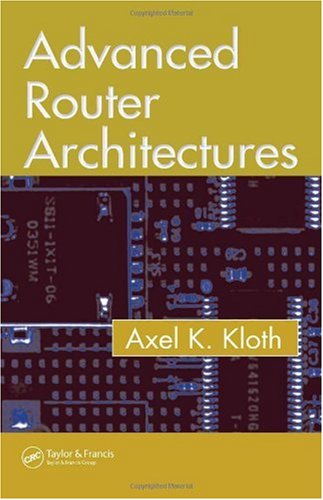(Ebook PDF) Advanced Router Architectures 1st Edition by Axel Kloth ISBN 9781351836982 1351836986 full chapters
$50.00 Original price was: $50.00.$35.00Current price is: $35.00.
Advanced Router Architectures 1st Edition Axel K. Kloth Digital Instant Download
Author(s): Axel K. Kloth
ISBN(s): 9780849335501, 0849335507
Edition: 1
File Details: PDF, 9.32 MB
Year: 2005
Language: english
(Ebook PDF) Advanced Router Architectures 1st Edition by Axel Kloth -Ebook PDF Instant Download/Delivery:9781351836982, 1351836986
Instant download Full Chapter of Advanced Router Architectures 1st Edition after payment

Product details:
ISBN 10:1351836986
ISBN 13:9781351836982
Author: Axel K. Kloth
Routers, switches, and transmission equipment form the backbone of the Internet, yet many users and service technicians do not understand how these nodes really work. Advanced Router Architectures addresses how components of advanced routers work together and how they are integrated with each other. This book provides the background behind why these building blocks perform certain functions, and how the function is implemented in general use. It offers an introduction to the subject matter that is intended to trigger deeper interest from the reader. The book explains, for example, why traffic management may be important in certain applications, what the traffic manager does, and how it connects to the rest of the router. The author also examines the implications of the introduction or omission of a traffic manager into an advanced router. The text offers a similar analysis for other router topics such as QOS and policy enforcement, security processing (including DoS/DDoS), and more. This book covers which mandatory and which optional building blocks can be found in an advanced router, and how these building blocks operate in conjunction to ensure that the Internet performs as expected.
Table of Contents:
- Chapter 1 Introduction
- Conclusion
- Chapter 2 Internet Topology Change
- Overview
- Current Status
- Traffic and Traffic Growth
- Conclusion
- Chapter 3 The Carrier Business Model
- Overview
- Service Level Agreements (SLAs)
- The VoIP Business Model
- Internal Corporate Accounting
- Conclusion
- Chapter 4 Advanced Routers in Central Office Applications
- Overview
- Central Office (CO) Colocation
- Conclusion
- Chapter 5 Function Split
- Overview
- Traditional System Partitioning and Function Split
- Functions within the Port Card
- Functions within the Processor Card
- Functions within the Switch Card
- Functions within the OAM&P Card
- Conclusion
- Chapter 6 High Availability
- Overview
- Definition
- Implications
- Network View of Redundancy and Failsafe Operation
- Example
- Design Life Time and Single Point of Failure Impact
- Definition of Availability
- 1+1 Redundancy
- 1:1 Redundancy
- 2 out of 3 (or N out of N+1) Redundancy
- Redundant Switch Fabric Cards
- Redundant Line Cards
- Redundant Links
- Redundant Power Supplies
- Software Robustness
- OAM&P Control over Redundant Subsystems
- Timed Switchover
- Switchover on Demand
- Reducing Human Error Probability
- Conclusion
- Chapter 7 The Chassis
- Overview
- Single-board versus Modular Designs
- Modular Designs
- Power Supply Considerations
- Single-board Designs
- Midplane Designs
- The Card Cage
- Power Supply Unit
- Fan Trays
- Backplane Designs
- The Card Cage
- Power Supply Unit
- Fan Trays
- Conclusion
- Chapter 8 Line Cards
- Overview
- Line Card Functions in IPv6 Routers
- Definitions
- Definition of a Line Card
- Definition of a Port Card
- Definition of a Processor Card
- Functional Requirements
- Data Loss and Higher Layers
- Distribution of Traffic
- Traffic Manager Functions versus Queue Manager Functions
- Ingress-side Traffic Management
- Further Impact of Advanced Router Architectures
- Line Cards as Server NICs
- Scalability
- Differentiation of Functions
- Line Card Implementation in Single-board Designs
- Line Card Implementation in Midplane Designs
- Line Card Implementation in Backplane Designs
- Line Card Messaging and Communications
- Internal Line Card to Line Card Communication
- Internal Line Card to Switch Fabric Communication
- Line Card to Switch Fabric Queue Manager Communication
- Line Card to External Resources Communication
- Interior and Exterior Border Gateway Protocols
- Line Card Functions for PSTN Internetworking
- Port Card Functions
- Definitions
- Network Processor and Traffic Manager Software Implications
- Local Control Processors for Line or Processor Cards
- Compute Efficiency
- Conclusion
- Chapter 9 Switch Fabric Cards
- Overview
- Functional Requirements for an Advanced Router’s Core
- History of Router-internal Interconnects
- Basics
- Externally Controlled Switches
- The Scheduling Challenge
- Crosspoint Switches and Crossbar Switches
- Self-routing Switches
- LCI
- Shared Memory Switches
- Non-buffered, Non-queued Switch Fabrics
- Buffered and Queued Switch Fabrics
- Combined Virtually Output Queued (CVOQ) Switch Fabrics
- Cleaner and Easier Logical and Functional Partitioning
- Easier Routing of Traces on the Backplane
- Higher Throughput of the Switch Fabric
- Less Incremental Cost for Upgrades
- Metrics of Switch Fabrics
- Net Bit Rate or Link Rate Utilization (Minimum, Maximum, Average)
- Throughput (Total and on a per-Link Basis)
- System Availability (Minimum)
- System Uptime (Minimum)
- Reliability (Error Rate)
- Logical Connection Setup Time (Minimum, Maximum, Average)
- Logical Connection Teardown Time (Minimum, Maximum, Average)
- Delay and Latency
- Round-Trip Delay (Minimum, Maximum, Average)
- Cell Delay Variation (CDV) (Minimum, Maximum, Average)
- Scalability
- Field Upgradability
- Resource Utilization on the Network Processor
- Cost Structure
- Feasibility
- Performance Extension
- Blocking Multi-stage Switches
- Non-blocking Multi-stage Switches
- Bit Slicing
- Cell Slicing
- Load Sharing across N Planes
- Master/Slave or “Performance Extension Architectures”
- Alternative Solutions
- “Pay-as-you-grow Solutions”
- The “Switchless Switch”
- Multicast and Broadcast
- Bandwidth Overprovisioning
- Traffic Manager Functions versus Queue Manager Functions
- Switch Fabric Queue Manager
- Deterministic Behavior
- Switch Fabric I/O
- Software Function Set in Local Switch Fabric Control
- Conclusion
- Chapter 10 Operation, Administration, Maintenance and Provisioning
- Overview
- Definition of OAM&P
- Functions of the OAM&P entity
- Operational Statuses
- Status Transitions
People also search:
advanced router techniques
advanced router
advanced routing
advanced network architecture
advanced routing engine
Tags:
Axel Kloth,Advanced,Router Architectures

